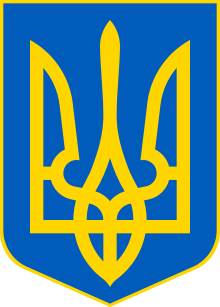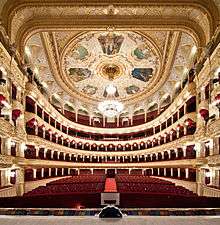Theater in Ukraine
| Part of a series on |
| Ukrainians |
|---|
 |
| Diaspora |
|
see Template:Ukrainian diaspora |
| Closely-related peoples |
|
East Slavs (parent group) Boykos · Hutsuls · Lemkos · Rusyns Poleszuks · Kuban Cossacks Pannonian Rusyns |
| Culture |
|
Architecture · Art · Cinema · Cuisine Dance · Language · Literature · Music Sport · Theater |
| Religion |
|
Eastern Orthodox (Ukrainian) Greek Catholicism Roman Catholicism Judaism (among ethnic Jews) |
| Languages and dialects |
|
Ukrainian Russian · Canadian Ukrainian · Rusyn · Pannonian Rusyn Balachka · Surzhyk · Lemko |
|
History · Rulers List of Ukrainians |
Theater in Ukraine (Ukrainian: Театральне мистецтво України, Teatralne mystetsvo Ukrayiny - Theatric Arts of Ukraine) is one of forms of fine arts that is also used as a way of cultural expression and identification of a level of cultural development in Ukraine. As a form of art is an artistic expression of life with a help of an actor's stage performance in front of spectators.
The Ukrainian theater as a national type of theater based on the native culture of Ukraine customs, traditions, language. The first traces of the Ukrainian theater can be identified in the early 19th century.
Historical background
Early years
The first theatrical acts could be traced back to 11th century when on the territory of Ukraine performed entertainers who are known in history as skomorokhi. There also were acts of religious drama based on the local church traditions. By 16-17th centuries religious dramas were conducted in schools and universities of Kyiv, Lviv, Ostroh. In 17-18th centuries there became very popular festivities of vertep.
The first stationary theater in Ukraine was opened (in Kharkiv 1789) in 1795 in Lviv which at that time was part of the Austrian Empire. The theater was located in the former Jesuit Church complex, the Kosciol of Saint Christ and Franciscan Monastery (1460-1848). The stationary theaters in the rest of Ukraine did not open until later, while theatrical troupes already existed and performed "on the road". However, in the early 19th there started to appear theaters in Kyiv (1806), Odessa (1809), Poltava (1808).
The founder of the classical Ukrainian drama became Ivan Kotlyarevsky who headed the Poltava Theater, while Hryhoriy Kvitka-Osnovyanenko became the founder of artistic prose in the modern Ukrainian literature. Burlesque and expressiveness tied with charm and humor, that characterize works of those two, have set a definition for an academic theater in Ukraine for some time.
Modern period
In the second half of the 19th century in Ukraine became popular the amateur theater. In those amateur circles started their career the coryphaei of Ukrainian theater Mykhailo Starytsky, Marko Kropyvnytsky and Ivan Karpenko-Karyi. The merit of rapid theater development belongs to the renowned family of Tobilevychi, members of which often performed under stage names Ivan Karpenko-Karyi, Mykola Sadovsky and Panas Saksahansky. Their private estate Khutir Nadia near Kropyvnytskyi was transformed into a National historic memorial site. Every of them not only created his own troupe, but also was a renowned actor and director. The leading female star of the Ukrainian theater of that time was Maria Zankovetska.
Soon after Ukraine its own statehood in 1918 in Kyiv was created the State Drama Theater and the "Young Theater" (later the theater "Berezil") of Les Kurbas and Hnat Yura. On a theatrical stage has appeared a cohort of talented actors: Amvrosiy Buchma, Maryan Krushelnytsky, Olimpiya Dobrovolska, Oleksandr Serdyuk, Natalya Uzhviy, Yuriy Shumsky and others. The State Drama Theater continued traditions of the realism-psychologism school, while the Young Theater was promoting Avant-garde. With the creation of Berezil theater its stage became a sort of experimental ground. It's no accident that mock-ups of the Theatrical Association "Berezil" received a gold medal at the 1925 International Exposition of Modern Industrial and Decorative Arts in Paris. At the theater were introduced for the first time the plays of renowned Ukrainian writers and dramaturges Mykola Kulish and Volodymyr Vynnychenko. Thanks to the genius Les Kurbas who combined several talents of director, actor, dramaturge and interpreter of world literature, the works of William Shakespeare, Henrik Ibsen, Gerhart Hauptmann, Friedrich Schiller and Molière were conceptualized anew at the Ukrainian scene and staged the unknown to the Ukrainian spectators until that time plays of the European dramaturges.
Theatrical library, museum and the first magazine take their beginning from the artistic association "Berezil". The contemporary artists to this day turn to the experimental searches of Les Kurbas who was repressed during the Stalinist period. In our time in Kyiv takes place the International Theatrical Festival "Artistic Berezillya" commemorated to Les Kurbas.
Theaters
There are two major groups of theaters in Ukraine: music-drama theaters and theaters of opera and ballet. Beside those there are also theaters of operetta, puppet theaters and others. Some ten theaters were recognized as national, an additional title to academical.
